Radiator section: the main types of structures and their
Anyone agrees that the comfort of living in a house primarily depends on maintaining the optimum temperature in the rooms, especially in the cold season. Therefore, today we will tell you how to choose the right radiators - how many sections per square meter you need, and consider how to independently carry out all the necessary calculations in order to get the most accurate and realistic result.
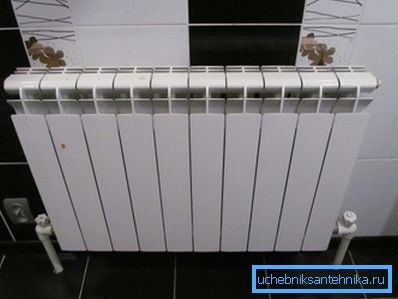
The main types of structures and their characteristics
If you want to get an answer to the question of how many radiator sections you need per 1 m2, then first of all you need to know what type of batteries will be used indoors, because the characteristics of the products differ quite a lot. That is why we will tell you the features of the most popular options; sectional constructions with a center distance of 500 mm were taken as the basis:
| Cast iron | These structures are well known to everyone, they have been used for more than a century and are still very common, and are in demand due to durability, immunity to low-quality coolant and corrosion resistance, and the price of this option is low. As for efficiency, one section gives out about 100 watts, higher values are indicated in the documentation, but the actual values are lower |
| Steel | This group of products is characterized by low cost, good heat dissipation and low weight, from the minuses should be allocated instability to hydraulic shocks (therefore, they are best used in individual heating systems) and increased corrosion in the system when there is no coolant. As for heat transfer, it varies in the range from 120 to 140 watts depending on the product configuration |
| Aluminum | A very popular solution today that has a number of undoubted advantages: low weight, which simplifies the installation process with your hands, high heat transfer (one section gives about 200 watts) and low cost. Among the shortcomings it is possible to note the low resistance to hydraulic impacts and demands on the quality of the heat carrier, since various impurities cause corrosion processes in the system. |
| Bimetallic | First, we will tell what a bimetal is, this is a structure representing aluminum sections, inside of which there is a steel core. Thanks to this device, the reliability of products increases many times, and the heat transfer is very high, so one section on average gives from 150 to 180 watts. The biggest disadvantage is the high cost of products. |
Note! In order to maximize the heat emission of your radiators, it is necessary to flush the system at least once a year. The fact is that even 1 millimeter of deposits inside the radiators reduces their efficiency by 15%, and this not only worsens the quality of heating, but also causes increased costs of energy carriers.
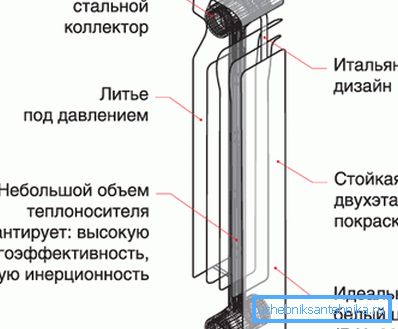
Basic settlement options
Now let's figure out how to choose the number of sections of a heating radiator for a particular room, there are many techniques, we will consider only those that are easiest to implement and give a relatively accurate result.
Simplified Method
If you use this option, you need to be guided by the following principle: for premises in central Russia, located in a high-rise building, which has one outer wall and one window, the required thermal power is 100 W per m2. The height of the ceilings should not exceed 2.8 meters.
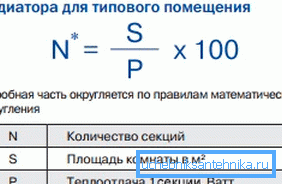
Consider a specific example, you only need to know how much m2 in the room:
- Suppose we have a room of 15 square meters with one window and one external wall, the height of the ceilings in it is 2.5 meters;
- Cast iron radiators with 50 mm center distance will be used for heating;
- It's all very simple: the number of radiator sections per 1 m2 is 1, that is, 15 sections are needed for 15 meters. Of course, if you have a coolant temperature in the system equal to 90 degrees, then the heat output of the batteries will be about 150 watts, and you will have 10 edges, but in practice there are almost no such cases, on average, the liquid heats up to 70 degrees;
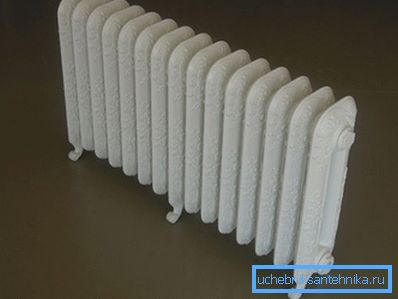
- If you have a corner room or ceiling height of 3 meters or higher, then the result must be multiplied by 1.2-1.3, depending on the quality of wall insulation and the type of window blocks used.
Note! In addition to all the factors listed above, the type of installation of radiators and the type of their connection also matters, so consider these nuances and, if necessary, make amendments to the final result.
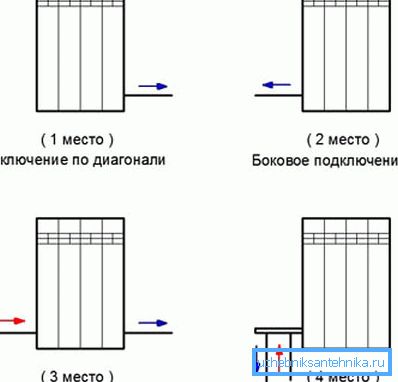
Use of online calculators
Instructions for carrying out this type of calculation is also very simple, the most important thing is to find a quality resource with a good program that takes into account the maximum number of additional factors. This is the only way to ensure that you determine exactly how many square meters will be enough for one or another variant of radiators.
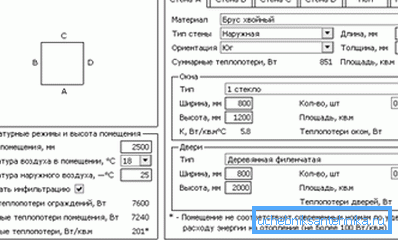
As for the calculations, they are simple:
- Enter all requested data in the program fields., the more reliable and accurate they are, the better, because it affects the correctness of the calculations;
- If there are no criteria in the calculator, then you simply multiply the result by a certain index (for example, the location of radiators is not always taken into account, but when determining how many radiator sections are needed, this factor cannot be overlooked).
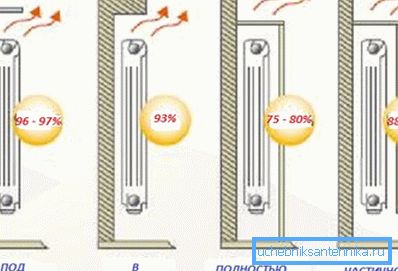
Calculation based on volume
A very popular option in view of the fact that it allows calculating the number of sections very accurately, some argue that the resulting value is overestimated, but it’s better to put the radiator on 12 sections instead of the required 10 and to maintain the desired temperature using the regulator than to set the radiator on 8 sections and more frost use additional heaters.
As for this technique, it is simple: it is necessary to measure the actual length, width and height of the room and multiply the values between each other, the result will be the volume in cubic meters. This value is multiplied by 41 - this is exactly how many watts are needed per cubic meter of air, with good insulation and the use of energy-saving double-glazed windows, 34 watts per cubic meter are sufficient.
When calculating, consider the size of the section of radiator heating, sometimes you have to put the radiators lower than planned due to the characteristics of the room.
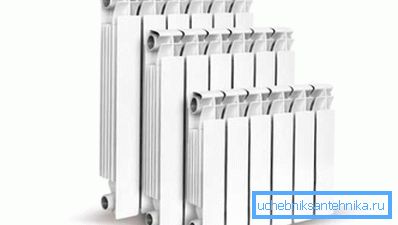
Some developers ask what to do if the calculation was made incorrectly and the installation of additional sections of radiators is required? There may be two solutions - either add elements to the already installed structure (its width should not exceed 16 ribs), or put a separate battery, it all depends on which option is simpler to implement and is better suited to a particular room.
Conclusion
Calculate the required number of sections of the radiator by any developer, the main thing is not to lose sight of the important nuances and use only quality products. The video in this article will help to sort out some issues more thoroughly, it will help you to make calculations even better.